airbag off Acura ZDX 2012 Owner's Manual
[x] Cancel search | Manufacturer: ACURA, Model Year: 2012, Model line: ZDX, Model: Acura ZDX 2012Pages: 645, PDF Size: 16.36 MB
Page 8 of 645

ꭧ: If equippedDRIVER'S FRONT
AIRBAG (P. 10, 28)
DRIVING POSITION
MEMORY SYSTEM
(P. 180)
POWER DOOR LOCK
MASTER SWITCH
(P. 151)
ACCESSORY POWER
SOCKETS (P. 217)
POWER WINDOW
SWITCHES
(P. 171) POWER TAILGATE
BUTTON (P. 153)
HOOD RELEASE
HANDLE (P. 457) PARKING BRAKE
PEDAL (P. 176)
AUXILIARY INPUT JACKS (P. 371)
INSTRUMENT PANEL INDICATORS (P. 63)
HOMELINK BUTTONS
(P. 396)PANORAMIC GLASS
ROOF SWITCH (P. 174)
MIRROR CONTROL
AUTO BUTTON
(P. 177)
PASSENGER'S
FRONT AIRBAG
(P. 10, 28)
CLIMATE CONTROL
SYSTEM (P. 220)
AUDIO SYSTEM
(P. 228)
AUTOMATIC
TRANSMISSION
(P. 477)
GAUGES (P. 76)
REAR SEAT HEATER
SWITCHES
ꭧ(P. 170)USB ADAPTER CABLE
(P. 257, 266, 342, 351)
MULTI-INFORMATION DISPLAY (P. 78)
Vehicle with navigation system is shown. INTEGRATED DYNAMICS
SYSTEM (IDS) SWITCH
ꭧ
(P. 519) PASSENGER AIRBAG
OFF INDICATOR (P. 36)
HAZARD WARNING
BUTTON (P. 143)
CONTINUED
Your Vehicle at a Glance
3
Your Vehicle at a Glance
09/10/28 17:15:37 10 ACURA ZDX KA KC New North America Own 50 31SZN600 enu
Page 10 of 645

This section gives you important
information about how to protect
yourself and your passengers. It shows
you how to use seat belts. It explains
how your airbags work. And it tells you
how to properly restrain infants and
children in your vehicle.
Important Safety Precautions
..............
6
Your Vehicle's Safety Features
............
8
Seat Belts
.....................................
9
Airbags
.......................................
10
Protecting Adults and Teens
.............
12
1. Close and Lock the Doors
..........
12
2. Adjust the Front Seats
...............
14
3. Adjust the Seat-Backs
................
15
4. Adjust the Head Restraints
.........
15
5. Fasten and Position the Seat Belts
...................................
16
6. Maintain a Proper Sitting Position
...............................
18
Advice for Pregnant Women
..........
19
Additional Safety Precautions
........
20
Additional Information About Your Seat Belts
...............................
21
Seat Belt System Components
.......
21 Lap/Shoulder Belt
........................
22
Automatic Seat Belt Tensioners
.....
23
Seat Belt e-pretensioners
...............
24
Seat Belt Maintenance
..................
25
Additional Information About Your
Airbags
...................................
26
Airbag System Components
..........
26
How Your Front Airbags Work
......
28
How Your Side Airbags Work
........
32
How Your Side Curtain Airbags Work
......................................
33
How the SRS Indicator Works
.......
34
How the Side Airbag Off Indicator Works
.....................................
35
How the Passenger Airbag Off Indicator Works
.......................
36
Airbag Service
.............................
37
Additional Safety Precautions
........
37
Protecting Children -General
Guidelines
..............................
39
All Children Must Be Restrained
...............................
39
All Children Should Sit in a Back Seat
........................................
40
The Passenger's Front Airbag Can Pose Serious Risks
...................
40 If You Must Drive with Several
Children
..................................
42
If a Child Requires Close Attention
.................................
42
Additional Safety Precautions
........
42
Protecting Infants and Small Children
.................................
44
Protecting Infants
.........................
44
Protecting Small Children
.............
45
Selecting a Child Seat
......................
47
Installing a Child Seat
......................
48
Installing a Child Seat with LATCH
...................................
49
Installing a Child Seat with a Lap/
Shoulder Belt
...........................
51
Installing a Child Seat with a Tether
.....................................
53
Protecting Larger Children
...............
54
Checking Seat Belt Fit
..................
54
Using a Booster Seat
....................
55
When Can a Larger Child Sit in Front
.......................................
56
Additional Safety Precautions
........
57
Carbon Monoxide Hazard
................
58
Safety Labels
..................................
59
Driver and Passenger Safety
5
Driver and Passenger Safety
09/10/28 17:15:37 10 ACURA ZDX KA KC New North America Own 50 31SZN600 enu
Page 16 of 645

The most important things you need
to know about your airbags are:●Airbags do not replace seat belts.They are designed to supplement
the seat belts.●Airbags offer no protection in rearimpacts, or minor frontal or sidecollisions.●Airbags can pose serious hazards.To do their job, airbags must
inflate with tremendous force. So
while airbags help save lives, they
can cause minor injuries or more
serious or even fatal injuries if
occupants are not properly
restrained or sitting properly.
What you should do:
Always wear
your seat belt properly, and sit
upright and as far back from the
steering wheel as possible while
allowing full control of the vehicle. A
front passenger should move their
seat as far back from the dashboard
as possible. The rest of this section gives more
detailed information about how you
can maximize your safety.
Remember, however, that no safety
system can prevent all injuries or
deaths that can occur in a severe
crash, even when seat belts are
properly worn and the airbags
deploy.
Your Vehicle's Safety Features
11
Driver and Passenger Safety
09/10/28 17:15:37 10 ACURA ZDX KA KC New North America Own 50 31SZN600 enu
Page 23 of 645

Never place the shoulder portion of alap/shoulder belt under your arm or
behind your back.
This could cause
very serious injuries in a crash.
If a seat belt does not seem to work
properly, it may not protect the
occupant in a crash.
No one should sit in a seat with an
inoperative seat belt.
Using a seat
belt that is not working properly can
result in serious injury or death.
Have your dealer check the belt as
soon as possible.
See page 21 for additional
information about your seat belts and
how to take care of them. 6. Maintain a Proper Sitting
Position
After all occupants have adjusted
their seats and head restraints, and
put on their seat belts, it is very
important that they continue to sit
upright, well back in their seats, with
their feet on the floor, until the
vehicle is safely parked and the
engine is off.
Sitting improperly can increase the
chance of injury during a crash. For
example, if an occupant slouches, lies
down, turns sideways, sits forward,
leans forward or sideways, or puts
one or both feet up, the chance of
injury during a crash is greatly
increased. In addition, an occupant who is out of
position in the front seat can be
seriously or fatally injured in a crash
by striking interior parts of the
vehicle or being struck by an
inflating front airbag.
Protecting Adults and Teens1809/10/28 17:15:37 10 ACURA ZDX KA KC New North America Own 50 31SZN600 enu
Page 29 of 645
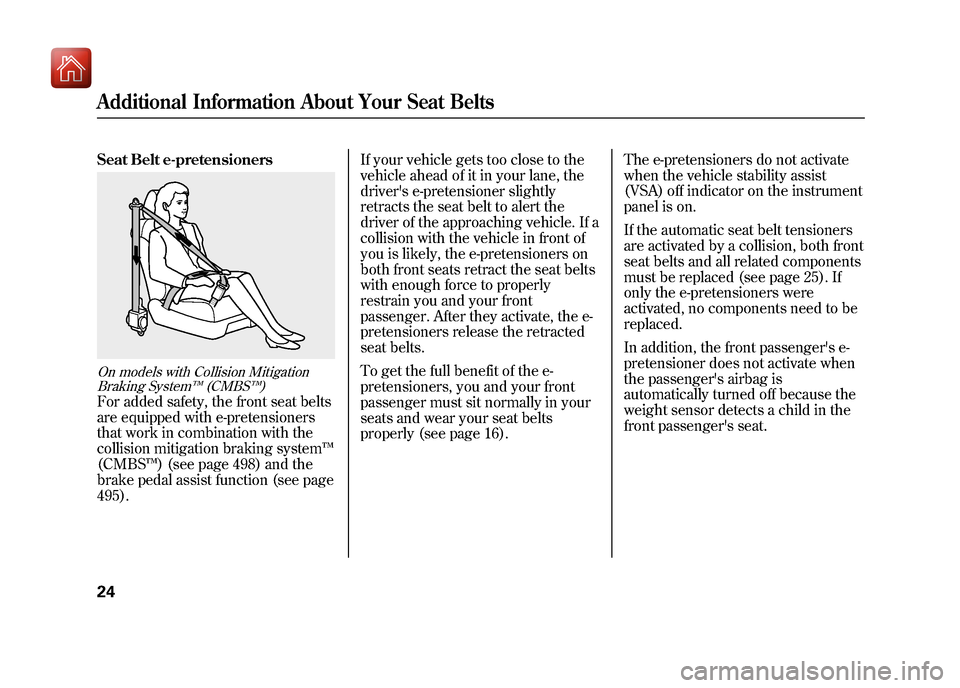
Seat Belt e-pretensionersOn models with Collision MitigationBraking System ™(CMBS ™)For added safety, the front seat belts
are equipped with e-pretensioners
that work in combination with the
collision mitigation braking system ™
(CMBS ™) (see page 498) and the
brake pedal assist function (see page
495). If your vehicle gets too close to the
vehicle ahead of it in your lane, the
driver's e-pretensioner slightly
retracts the seat belt to alert the
driver of the approaching vehicle. If a
collision with the vehicle in front of
you is likely, the e-pretensioners on
both front seats retract the seat belts
with enough force to properly
restrain you and your front
passenger. After they activate, the e-
pretensioners release the retracted
seat belts.
To get the full benefit of the e-
pretensioners, you and your front
passenger must sit normally in your
seats and wear your seat belts
properly (see page 16).
The e-pretensioners do not activate
when the vehicle stability assist
(VSA) off indicator on the instrument
panel is on.
If the automatic seat belt tensioners
are activated by a collision, both front
seat belts and all related components
must be replaced (see page 25). If
only the e-pretensioners were
activated, no components need to be
replaced.
In addition, the front passenger's e-
pretensioner does not activate when
the passenger's airbag is
automatically turned off because the
weight sensor detects a child in the
front passenger's seat.Additional Information About Your Seat Belts2409/10/28 17:15:37 10 ACURA ZDX KA KC New North America Own 50 31SZN600 enu
Page 31 of 645
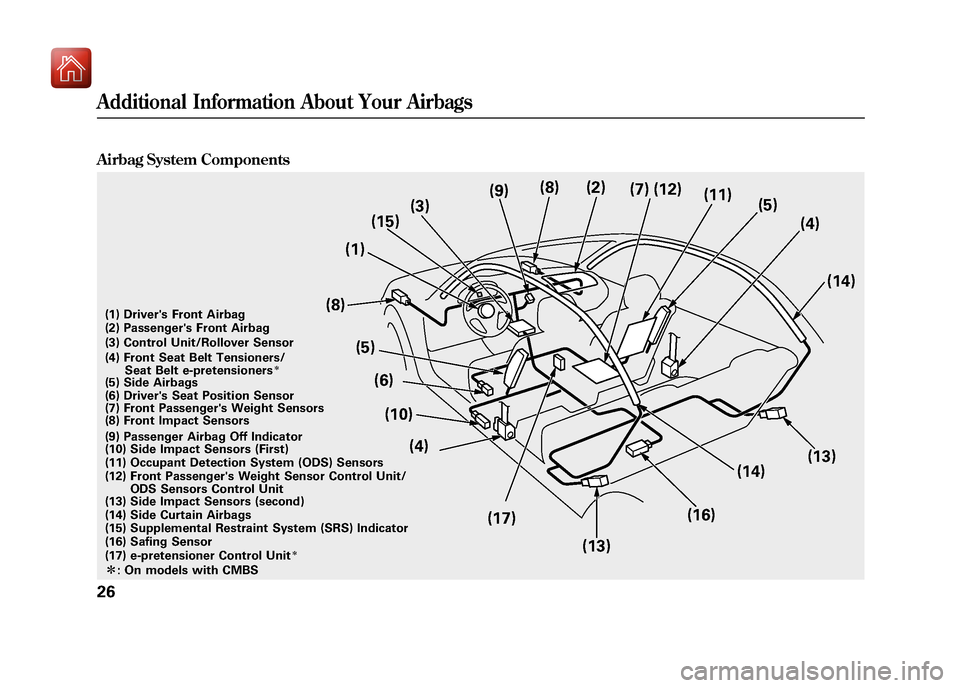
Airbag System Components
(2)
(3)
(6)
(1)
(9)
(5)
(10) (11)
(12)
(14)
(13)
(15)
(16)
(17) (8)
(7)
(4)
(14)
(13)
(4)
(5)
(17) e-pretensioner Control Unit
ꭧ
(16) Safing Sensor (15) Supplemental Restraint System (SRS) Indicator
(14) Side Curtain Airbags
(13) Side Impact Sensors (second) (12) Front Passenger's Weight Sensor Control Unit/ (11) Occupant Detection System (ODS) Sensors (10) Side Impact Sensors (First) (9) Passenger Airbag Off Indicator (8) Front Impact Sensors (7) Front Passenger's Weight Sensors (6) Driver's Seat Position Sensor (5) Side Airbags (4) Front Seat Belt Tensioners/ (3) Control Unit/Rollover Sensor (2) Passenger's Front Airbag (1) Driver's Front Airbag
(8)
ꭧ
: On models with CMBS ODS Sensors Control Unit
Seat Belt e-pretensioners
ꭧ
Additional Information About Your Airbags2609/10/28 17:15:37 10 ACURA ZDX KA KC New North America Own 50 31SZN600 enu
Page 32 of 645
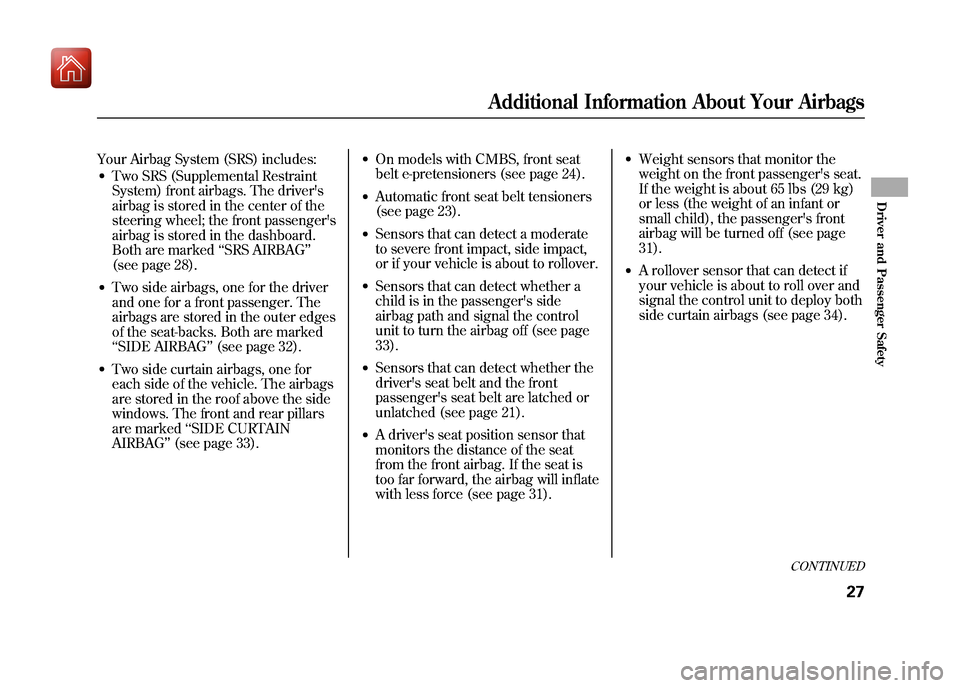
Your Airbag System (SRS) includes:●Two SRS (Supplemental Restraint
System) front airbags. The driver's
airbag is stored in the center of the
steering wheel; the front passenger's
airbag is stored in the dashboard.
Both are marked‘‘SRS AIRBAG ’’
(see page 28).●Two side airbags, one for the driver
and one for a front passenger. The
airbags are stored in the outer edges
of the seat-backs. Both are marked
‘‘ SIDE AIRBAG ’’(see page 32).●Two side curtain airbags, one for
each side of the vehicle. The airbags
are stored in the roof above the side
windows. The front and rear pillars
are marked ‘‘SIDE CURTAIN
AIRBAG ’’(see page 33).
●On models with CMBS, front seat
belt e-pretensioners (see page 24).●Automatic front seat belt tensioners
(see page 23).●Sensors that can detect a moderate
to severe front impact, side impact,
or if your vehicle is about to rollover.●Sensors that can detect whether a
child is in the passenger's side
airbag path and signal the control
unit to turn the airbag off (see page
33).●Sensors that can detect whether the
driver's seat belt and the front
passenger's seat belt are latched or
unlatched (see page 21).●A driver's seat position sensor that
monitors the distance of the seat
from the front airbag. If the seat is
too far forward, the airbag will inflate
with less force (see page 31).
●Weight sensors that monitor the
weight on the front passenger's seat.
If the weight is about 65 lbs (29 kg)
or less (the weight of an infant or
small child), the passenger's front
airbag will be turned off (see page
31).●A rollover sensor that can detect if
your vehicle is about to roll over and
signal the control unit to deploy both
side curtain airbags (see page 34).
CONTINUED
Additional Information About Your Airbags
27
Driver and Passenger Safety
09/10/28 17:15:37 10 ACURA ZDX KA KC New North America Own 50 31SZN600 enu
Page 33 of 645
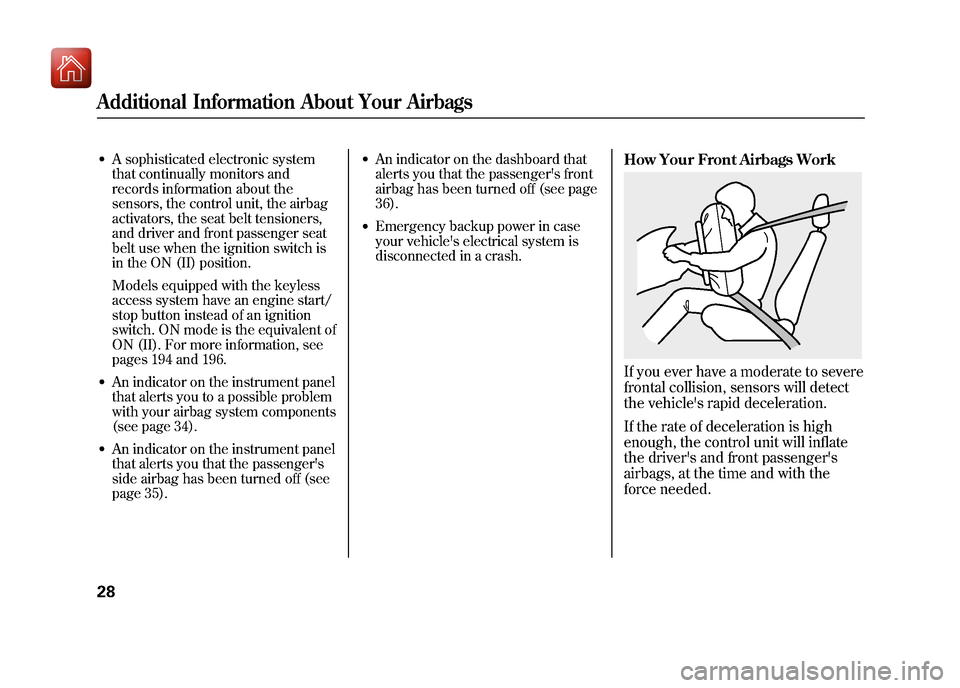
●A sophisticated electronic system
that continually monitors and
records information about the
sensors, the control unit, the airbag
activators, the seat belt tensioners,
and driver and front passenger seat
belt use when the ignition switch is
in the ON (II) position.
Models equipped with the keyless
access system have an engine start/
stop button instead of an ignition
switch. ON mode is the equivalent of
ON (II). For more information, see
pages 194 and 196.●An indicator on the instrument panel
that alerts you to a possible problem
with your airbag system components
(see page 34).●An indicator on the instrument panel
that alerts you that the passenger's
side airbag has been turned off (see
page 35).
●An indicator on the dashboard that
alerts you that the passenger's front
airbag has been turned off (see page
36).●Emergency backup power in case
your vehicle's electrical system is
disconnected in a crash.
How Your Front Airbags WorkIf you ever have a moderate to severe
frontal collision, sensors will detect
the vehicle's rapid deceleration.
If the rate of deceleration is high
enough, the control unit will inflate
the driver's and front passenger's
airbags, at the time and with the
force needed.
Additional Information About Your Airbags2809/10/28 17:15:37 10 ACURA ZDX KA KC New North America Own 50 31SZN600 enu
Page 34 of 645
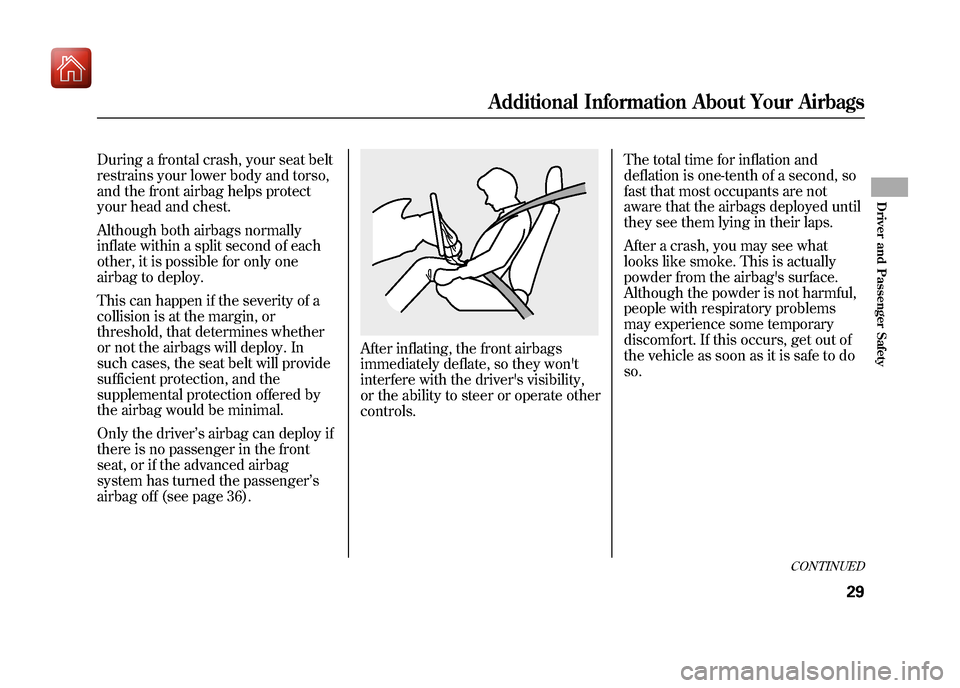
During a frontal crash, your seat belt
restrains your lower body and torso,
and the front airbag helps protect
your head and chest.
Although both airbags normally
inflate within a split second of each
other, it is possible for only one
airbag to deploy.
This can happen if the severity of a
collision is at the margin, or
threshold, that determines whether
or not the airbags will deploy. In
such cases, the seat belt will provide
sufficient protection, and the
supplemental protection offered by
the airbag would be minimal.
Only the driver’s airbag can deploy if
there is no passenger in the front
seat, or if the advanced airbag
system has turned the passenger ’s
airbag off (see page 36).
After inflating, the front airbags
immediately deflate, so they won't
interfere with the driver's visibility,
or the ability to steer or operate other
controls. The total time for inflation and
deflation is one-tenth of a second, so
fast that most occupants are not
aware that the airbags deployed until
they see them lying in their laps.
After a crash, you may see what
looks like smoke. This is actually
powder from the airbag's surface.
Although the powder is not harmful,
people with respiratory problems
may experience some temporary
discomfort. If this occurs, get out of
the vehicle as soon as it is safe to do
so.
CONTINUED
Additional Information About Your Airbags
29
Driver and Passenger Safety
09/10/28 17:15:37 10 ACURA ZDX KA KC New North America Own 50 31SZN600 enu
Page 36 of 645
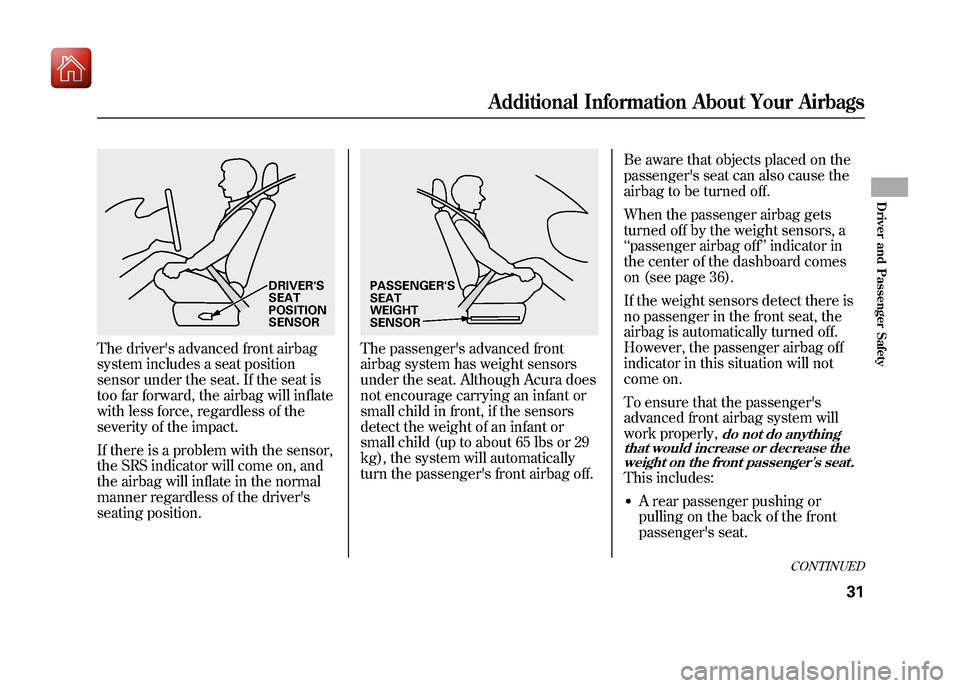
The driver's advanced front airbag
system includes a seat position
sensor under the seat. If the seat is
too far forward, the airbag will inflate
with less force, regardless of the
severity of the impact.
If there is a problem with the sensor,
the SRS indicator will come on, and
the airbag will inflate in the normal
manner regardless of the driver's
seating position.
The passenger's advanced front
airbag system has weight sensors
under the seat. Although Acura does
not encourage carrying an infant or
small child in front, if the sensors
detect the weight of an infant or
small child (up to about 65 lbs or 29
kg), the system will automatically
turn the passenger's front airbag off.Be aware that objects placed on the
passenger's seat can also cause the
airbag to be turned off.
When the passenger airbag gets
turned off by the weight sensors, a
‘‘
passenger airbag off ’’indicator in
the center of the dashboard comes
on (see page 36).
If the weight sensors detect there is
no passenger in the front seat, the
airbag is automatically turned off.
However, the passenger airbag off
indicator in this situation will not
come on.
To ensure that the passenger's
advanced front airbag system will
work properly,
do not do anything
that would increase or decrease the weight on the front passenger's seat.
This includes:●A rear passenger pushing or
pulling on the back of the front
passenger's seat.
DRIVER'S
SEAT
POSITION
SENSOR
PASSENGER'S
SEAT
WEIGHT
SENSOR
CONTINUED
Additional Information About Your Airbags
31
Driver and Passenger Safety
09/10/28 17:15:37 10 ACURA ZDX KA KC New North America Own 50 31SZN600 enu